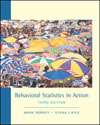 |  Behavioral Statistics in Action, 3/e Mark W. Vernoy,
Palomar College
Diana J. Kyle,
Fullerton College
Experimental Design
Learning ObjectivesUpon completion of this chapter, students should know
| How to generate, define, and identify null and research hypotheses. |
 |  |  | | How to define and differentiate between the three major classifications of variables. |
 |  |  | | The purpose and fundamental elements of true experiments. |
 |  |  | | The impact of experimenter bias and demand characteristics to experimental findings. |
 |  |  | | How to define and distinguish between within-subjects, between-subjects, and mixed designs. |
 |  |  | | How to identify and to distinguish between the one-tailed and two-tailed hypotheses, and define their purposes. |
 |  |  | | The conceptual meaning of statistical significance. |
 |  |  | | How to define and differentiate between Type I and Type II errors in statistical decisions. |
 |  |  | | The concept of, factors that influence, and impact of statistical power in analyses. |
|



 2002 McGraw-Hill Higher Education
2002 McGraw-Hill Higher Education